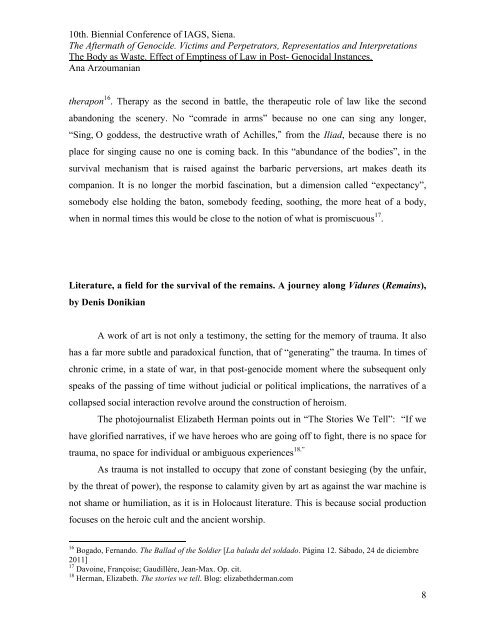10th. Biennial Conference of IAGS, Siena. The ... - Ana Arzoumanian
10th. Biennial Conference of IAGS, Siena. The ... - Ana Arzoumanian
10th. Biennial Conference of IAGS, Siena. The ... - Ana Arzoumanian
Create successful ePaper yourself
Turn your PDF publications into a flip-book with our unique Google optimized e-Paper software.
<strong>10th</strong>. <strong>Biennial</strong> <strong>Conference</strong> <strong>of</strong> <strong>IAGS</strong>, <strong>Siena</strong>.<strong>The</strong> Aftermath <strong>of</strong> Genocide. Victims and Perpetrators, Representatios and Interpretations<strong>The</strong> Body as Waste. Effect <strong>of</strong> Emptiness <strong>of</strong> Law in Post- Genocidal Instances.<strong>Ana</strong> <strong>Arzoumanian</strong>therapon 16 . <strong>The</strong>rapy as the second in battle, the therapeutic role <strong>of</strong> law like the secondabandoning the scenery. No “comrade in arms” because no one can sing any longer,“Sing, O goddess, the destructive wrath <strong>of</strong> Achilles,” from the Iliad, because there is noplace for singing cause no one is coming back. In this “abundance <strong>of</strong> the bodies”, in thesurvival mechanism that is raised against the barbaric perversions, art makes death itscompanion. It is no longer the morbid fascination, but a dimension called “expectancy”,somebody else holding the baton, somebody feeding, soothing, the more heat <strong>of</strong> a body,when in normal times this would be close to the notion <strong>of</strong> what is promiscuous 17 .Literature, a field for the survival <strong>of</strong> the remains. A journey along Vidures (Remains),by Denis DonikianA work <strong>of</strong> art is not only a testimony, the setting for the memory <strong>of</strong> trauma. It alsohas a far more subtle and paradoxical function, that <strong>of</strong> “generating” the trauma. In times <strong>of</strong>chronic crime, in a state <strong>of</strong> war, in that post-genocide moment where the subsequent onlyspeaks <strong>of</strong> the passing <strong>of</strong> time without judicial or political implications, the narratives <strong>of</strong> acollapsed social interaction revolve around the construction <strong>of</strong> heroism.<strong>The</strong> photojournalist Elizabeth Herman points out in “<strong>The</strong> Stories We Tell”: “If wehave glorified narratives, if we have heroes who are going <strong>of</strong>f to fight, there is no space fortrauma, no space for individual or ambiguous experiences 18.”As trauma is not installed to occupy that zone <strong>of</strong> constant besieging (by the unfair,by the threat <strong>of</strong> power), the response to calamity given by art as against the war machine isnot shame or humiliation, as it is in Holocaust literature. This is because social productionfocuses on the heroic cult and the ancient worship.16 Bogado, Fernando. <strong>The</strong> Ballad <strong>of</strong> the Soldier [La balada del soldado. Página 12. Sábado, 24 de diciembre2011]17 Davoine, Françoise; Gaudillère, Jean-Max. Op. cit.18 Herman, Elizabeth. <strong>The</strong> stories we tell. Blog: elizabethderman.com8



